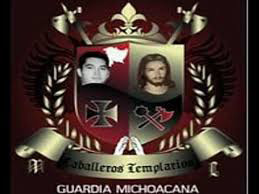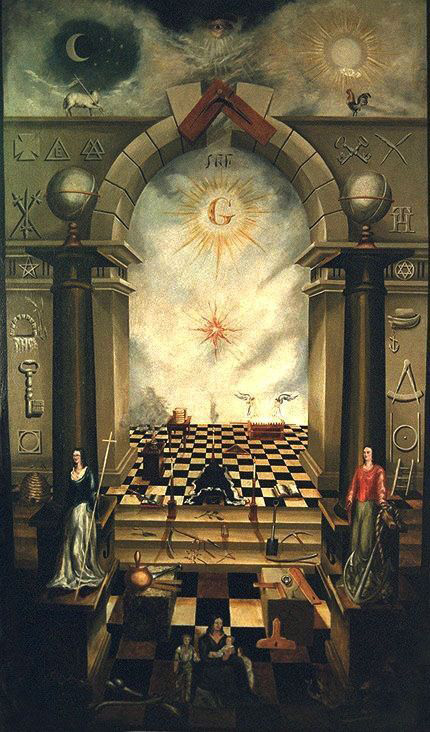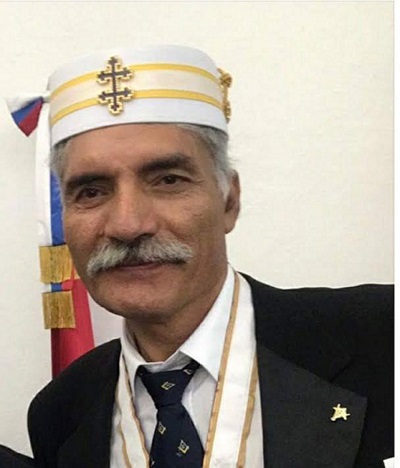Battle of the Brotherhood: The War Between the Caballeros Templarios and the Freemasons of Michoacán
Tony M. Kail
Note: This essay has been written specifically for Small Wars Journal—El Centro as part of an ongoing Los Caballeros Templarios de Michoacán research project that will be published as a future eBook.

Caballeros Templarios Coat of Arms

Freemason Symbols
The development of the Knights Templar Cartel brought together criminal and violent behaviors of a transnational criminal organization and cultural elements of a fraternal society. Elements including artifacts, customs, rituals and sacred texts echoed facets of many contemporary fraternal organizations. Likewise, some groups and individuals who publicly opposed the Knights Templar also embraced similar facets of a fraternal brotherhood. There are strands of fraternal culture that are weaved throughout the saga of the Knights Templar Cartel.
In August 2012 a Masonic publication known as The Templar Tribune and Supplement issued a warning to readers about the appearance of the Knights Templar Cartel in Mexico. The publication was written for members of a specific branch of Freemasonry known as the York Rite. Within the York Rite tradition there is a degree known as the ‘Knights Templar’ degree. The writer of the report was concerned that members of this degree might be mistaken for members of the deadly drug cartel. He shared:
“The effect of the narco-terrorists on the Knights Templars of masonic groups is that certain religious and news organizations will undoubtedly connect these actions to further disparage the recruitment of members. As in the case of a Masonic brother of mine discussing with me that his relatives had said that masons were burning down churches in Mexico.”
This confusion may be compounded when looking at the similarities between the Knights Templar Cartel and the history and culture of Freemasonry. The Knights Templar Cartel attempts to appropriate aesthetics and customs that the group believes to have been present among the historical order of the Knights Templar. This group of warrior monks that were charged with protecting pilgrims travelling to Jerusalem utilized a number of customs including the use of codes, oaths and passwords that are seen in contemporary Freemasonry. Some Masonic scholars believe that modern day Freemasonry can be traced back to the original Knights Templar.
There are several aspects of the Knights Templar Cartel that would suggest that the cartel’s creators had possible knowledge of Freemasonry. There are degrees associated with the two primary appendant branches of Freemasonry known as the York and Scottish Rites that focus on the Knights Templar. Several components of the cartel oaths that are taken by members have similarities to Masonic oaths and obligations. Cartel oaths include themes of prohibitions of sharing secrets, an importance of serving family and community, belief in a Supreme Being, references to a Templar ‘journey’, a promise to aid brother Templars and various punishments associated with revealing cartel secrets.
Similar themes are found in Freemasonry. The cartel code book Codigo De Los Caballeros Templarios De Michoacán also describes elements of oaths and obligations that are very similar to those in Freemasonry. The material culture of the cartel is similar to that found among Masonic York Rite Templars. Similar emblems, robes, swords and banners can be found among both organizations.
Fraternal culture could be seen not only in the work of the Templars Cartel but also in the culture of self-defense groups that sought to protect communities from the cartel. One of the most active groups working to protect Michoacán from cartels became known as the ‘Citizen Council of Self-Defense and Community of Michoacán’. Headed by leader Jose Manuel Mireles known as ‘El Doctor’, the group sought to drive the cartels out of local towns. Mireles publicly spoke out against the Templars sharing that he had been kidnapped, assaulted and had lost family as a result of Templar violence. Mireles became the face of Templar opposition as he led a highly publicized campaign with a citizen militia.

Dr. Jose Manuel Mireles known as ‘El Doctor’
Dressed in Masonic Scottish Rite Regalia
Glimpses of fraternal ties began to manifest as Mireles was featured in the 2015 documentary Cartel Land which focused on Mexico’s drug war. In one scene Mireles is wearing a Masonic ring featuring the fraternity’s square and compass. In another scene the camera pans across a table where Mireles is meeting with village elders and clearly shows a Masonic book with the square and compass on the cover. Mireles was also seen in a 2013 interview wearing a shirt adorned with the same Masonic symbol. As the war with the Templars continued more evidence of fraternal involvement would come to the surface.
Following the capture of Mireles by the Mexican government in 2014 the announcement of his arrest was announced in a local Masonic lodge. Mireles began to call upon members of Masonic orders during press interviews. In an interview with The Truth newspaper in July of 2014 Mireles boldly speaks of tools, rituals and philosophies found in Freemasonry. Mireles stated:
“Dear Brothers and Sisters of the different Masonic rites and of the different Great Orient of Michoacán and Mexico.
They make us common principles and deep values, those Masonic convictions and ideals that bring humanity closer to its most sacred expression. We receive Light and the Light we owe; We were born in a lodge that came to the laboratory of ideas, where projects are refined, where arms are interwoven, where character is tempered.
You, like me, equally stick to justice, equality, democracy and responsible freedom, as in the individual we fight against the vices and passions that hit our human nature.
We are heirs of the Pleiad of Freemasons who have forged a better homeland in the different corners of the world where the lodges have given birth to a new brother. As repositories of greatness that exalt the human spirit, when the homeland and society demand it, we are tacitly obliged to act beyond our means. It is not an option. Rather an obligatory act of congruence of whoever says Mason and is recognized as such by his brothers.
Freemasonry at this time must transcend the misinterpreted symbolism, towards action; from speculation, towards operability; from the Masonic historical dream, towards the transformation of our harsh reality.
What Michoacán and Mexico live is not for less. It is then necessary to recapitulate by stopping, in an act of humility, to see where our footprints come from as Freemasons; only deepening in our origin we will be able to bring our journey to good fortune.
As an act of dignity we have to transcend ourselves. Impossible to continue with this stupid inertia that throws more poor, that spills more blood and that sows of nightmares born with blood, death and injustice our soil. We definitely cannot continue like this.
I do not know about you, but I want to live the dream of the free man. In my dream the children of Mexico live, they do not survive; they dream, they do not wake up with anguish; They sow, they do not have to arm themselves for the sake of those who had to take care of the peace of the just.
That’s why I want to call them to be consistent with the historical moment we live. That if in his circumstances Hidalgo, Morelos, Juárez, Ocampo, Madero or Cárdenas disrupted the fictitious order established to offer us a better homeland, it is now up to these generations of freemasons to do the same to rescue us from the abyss into which they have submerged this country.
My call is to leave that unimportant masonry of four walls. My exhortation is to do something beyond your family and your immediate environment; My call is for you to organize and fight within the law for what you believe is fair for your children and the generations to come.
I invite you to fight together for justice and dignified peace, to give the best that we as Freemasons have to move forward our state and, with it, our families. I ask you to arm yourself but of value and that if you wield weapons these are the plumb line, the level, the chisel, the marro, the square and the compass so that under the shelter of the Masonic congruence we walk together. Our mission now is to grind to shape the cubic stone that can serve as the basis for the raising of a better country.
But if you decide that this is not your fight, I only ask that you be a carrier of your own Light arising under the principles and values emanating from the squadron and the compass. If you do this, be assured that we will meet in the fray for building a future, because the source of Masonic Light is only one.”
Mireles references to weapons like the plumb line, level, chisel, marro (hammer), square and compass are references to tools used by operative Masons in building but they are also important philosophical symbols in speculative Freemasonry. Mireles makes several references to esoteric Masonic concepts used in communicating with fellow Masons.
Masonic websites like Diario Masonico began to call for support from the Masonic brotherhood:
“But the issue that institutionally occupies us is the fulfillment of the Masonic duty that we all have through our oath, that of helping a brother who has been the object of serious humiliation to his dignity and condition of being human, without avoiding the illegalities and violations. to the process as already said before, through old customs of the state apparatus when you want to get rid of a nuisance or a stone in your way, only this time it is a cubic stone, which should not be easy to destroy, not we must allow it, we must understand and accept that it is not a criminal, that it is a political prisoner, but much more than that, this time it is a brother Mason.”
Lodges throughout Mexico began to call for the release of Mireles.
In May of 2016 Mireles released a message through his sister’s Facebook page apologizing for his role in creating self-defense groups. During the message he speaks of regrets concerning civil disobedience and concludes with:
“Finally I want to express gratitude to the entire Masonic fraternity for not having left me alone in my situation and that the great architect of the universe might fill your homes with the abundance of good to meet the needs of the entire family and to help a little the brothers fallen into disgrace or those who have less.”
What role did Freemasonry play in the formation and direction of the self-defense groups? As a Freemason Mireles would have been expected to be obedient to oaths and principles that focus on the protection of fellow Masons and their families in the community. Mireles did suffer a great loss when the cartels took the lives of his loved ones but did his fraternal motivation also encourage the formation of the defense groups? Did his fellow members of the organization also feel the need to answer a fraternal call to duty to assist Mireles in his crusade?
While Mireles and the self-defense groups discovered courage, strength and wisdom from Masonic inspiration, members of Los Caballeros Templarios found fraternal culture as inspiration to promote drug trafficking and violence. Ironically the same week that stories about the Templarios made international news in July 2011, the Knights Templar theme was also being mentioned amidst several acts of violence on the other side of the world. Templar aesthetics and lore were appropriated by Norwegian mass shooter Anders Behring Brevik as motivation for his killing spree that claimed the lives of over 70 victims.
Brevik had been expelled from a Norwegian Masonic fraternity where he learned about the Templars. The killer featured Templar references and images in his 1,500 page written and video manifestos that he posted to the Internet. Writer James Bosworth in Ritual America: Secret Brotherhoods and Their Influence on American Society asks an interesting question:
“Did an 800-year-old organization inspire violence on two continents this week? I doubt anyone thinks these two groups are linked. It’s just a coincidence that that they use the same name. Yet, it raises the question of what makes violent ideologies and criminals search the past for inspiration? And what makes two groups so far apart find that inspiration in the Knights Templar?”
The role that fraternal societies played in the life and times of the Knights Templar Cartel provided structure, identity and power to members and to their rivals. However, the fraternal brotherhood that is embraced by members of those opposing the cartel encouraged positive responses to very negative work being performed by a renegade cult that used fraternal customs. It is possible that we will continue to see fraternal societies as bonding mechanisms for many of the players in Mexico’s continuing war on drugs.
Resources
Cartel Land (2015), Directed by Matthew Heineman. Tim “Nailer” Foley, José Manuel ‘El Doctor’ Mireles, Enrique Peña Nieto. Grand Lodge of British Columbia and Yukon, http://freemasonry.bcy.ca/fiction/cartel_land.html.
José Manuel Mireles, “Masonic Message.” Diario Masónico. 20 July 2014. https://www.diariomasonico.com/opinion/mireles-mensaje-masonico.
“Mexico Drug War-Michoacán: Jose Mireles Apologizes for Creating Self-Defense Groups.” Mexico Voices. 10 January 2016. https://mexicovoices.blogspot.com/2016/01/mexico-drug-war-Michoacán-jose-mireles.html
Adam Parfery and Craig Heimbichner, Ritual America: Secret Brotherhoods and their Influence on American Society. Feral House, 2012.
“The Q.H. José M. Mireles is Illegally Detained.” Diario Masónico. 2 July 2014. https://www.diariomasonico.com/noticias/jose-mireles-detenido-ilegalmente.
The Templar Tribune and Supplement, August 2012, www.knightstemplar.org/KTnews/0812/NDAUG12.pdf.
